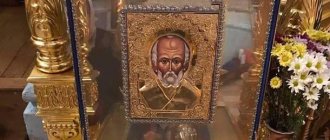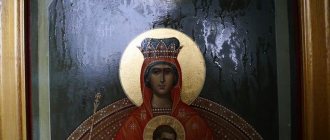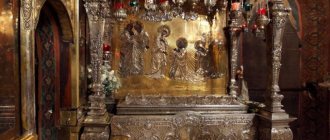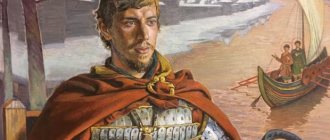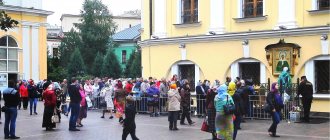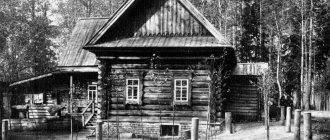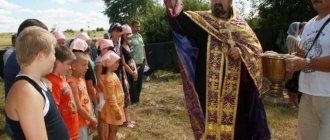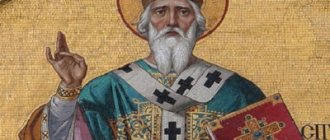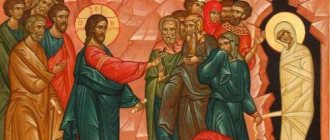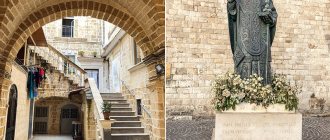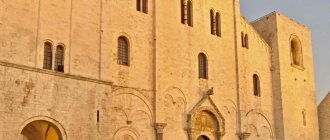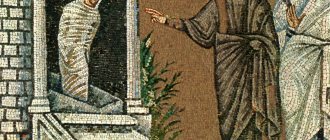Briefly about Saint Nicholas
A detailed life of the Miracle Worker of Myra was compiled by St. Dimitry Rostovsky. The saint was presumably born in 270 in the city of Patara (modern Türkiye). His parents were pious people, of noble origin and wealth. But wealth and high position did not harm them - they were merciful to those in need, believers, and prayers. For many years they prayed for the gift of a son, promising to dedicate the born child to the Lord. The merciful Lord heeded the prayers and gave the family a child.
Saint Nicholas is especially revered by the Russian Orthodox people
The son was baptized Nikolai. He was unlike other children: having excellent academic success, he did not waste time on empty conversations, avoided everything sinful, read Scripture for a long time and prayed. Over time, he was ordained as a reader, and later he became a presbyter.
The saint took part in the Ecumenical Council, denounced Arius and personally struck the wicked man on the cheek, defending Orthodoxy. During his earthly life, he served many people and the church.
Acts and miracles of Nicholas the Wonderworker
Church tradition contains many amazing stories about St. Nicholas. For example, he helped collect a dowry for the three daughters of a ruined rich man. This allowed them to marry safely and thus avoid shame. After all, the desperate father intended to use the girls’ beauty for shameful earnings. Saint Nicholas secretly planted gold three times for each daughter. Twice he managed to return home undetected. But the third time, the girls’ father tracked them down, recognized his benefactor and, in gratitude, threw himself at his feet. The saint ordered not to tell anyone about his act.
In his youth, Saint Nicholas went to study in the city of Alexandria. During a sea voyage, he resurrected a sailor who had died from a fall from a height. On the way back, the saint saved another sailor.
One day, a rebellion broke out in one of the provinces of the empire, and Tsar Constantine I sent an army to suppress it. During the campaign, the soldiers had a camp near the city of Myra. Some warriors began to loot and oppress the local population, which led to unrest. Saint Nicholas found out about this, immediately went to the military leaders and convinced them to pacify the soldiers.
Saint Nicholas also saved three governors who were sentenced to death on the false accusation of envious people of plotting against the emperor. On the night before the execution, the condemned in prison prayed to St. Nicholas, with whom they were personally acquainted. Saint Nicholas appeared to the emperor in a dream and strictly ordered the release of the innocently convicted. The tsar freed the governor and through them gave gifts to St. Nicholas.
History of the relics of the miracle worker
The saint was awarded a long life, and already in his old age he passed away in peace to the Lord. This happened around the year 342, according to the new style on December 19. The body of the deceased was buried in the temple, it remained incorrupt. An extraordinary fragrance emanated from him, an unearthly myrrh exuded.
Believers who worshiped the saint were healed of illnesses. This became widely known, and Christians from other cities and countries began to flock to the tomb to receive healing for diseases not only of the body, but also of the soul.
Burial place of the saint
The body of the saint, laid in the city temple in Myra of Lycia, remained in place until the 11th century. It is unknown when he was officially canonized, but people began to glorify him as a saint almost immediately after his death.
Currently, only ruins remind of the temple in Myra, where the saint rested. The city was renamed. Now it is called Demre and is located in what is now Turkey.
Broken tomb of St. Nicholas in Myra Lycia
Transfer of relics to Italy
In the XI century. Myra, as well as many Byzantine cities, came under Turkish rule. At the same time, the Italians from the city of Bari especially wanted to obtain the holy relics so that the saint would become the patron saint of their city. The events took place in 1087, after the Great Schism, which resulted in the formation of a Catholic organization that boldly called itself the church.
Catholics began to organize and conduct Crusades. Many people died under their swords. They stole the relics of the Miracle Worker of Myra and brought them to the city of Bari.
Despite the surviving historical facts of non-Christian behavior of Catholics, Italians like to tell a different story of the transfer of the shrine to their city. According to local residents, the saint appeared to a priest in a dream and ordered the relics lying in the city captured by the Turks to be taken to Europe. This legend raises a lot of questions, and above all, it reminds us of the attitude of the saint himself to heresy and his blow to the cheek of the wicked Arius. Italians annually remember the relocation of the shrine with a costumed carnival.
Relics of St. St. Nicholas the Wonderworker in the Basilica of Bari, Italy
Where are the relics of St. Nicholas now
Currently, the shrine is located in many cities and countries in the form of particles. In the Italian cities of Bari and Venice, crayfish with relics remained from the time of the Crusades, but these are only parts of them. There they rest permanently, only sometimes they can be transported to other places for worship. In addition to Italy, many pieces of relics are located in Russia.
In 2022, the relics were brought from Bari to Moscow. This event was a consequence of the signing of the declaration of St. Cyril and Pope Francis in 2016. The document became the starting point for accustoming the Orthodox to joint prayers with heretics and, as a result, their violation of the Apostolic and Council rules. In fact, there was no need for this action, since there are also parts of the relics of St. Nicholas the Pleasant in Russia. The relics were specially brought in a large shrine, as if the whole body rested in it. But only part of them rests in Italy.
The saint's memorial day is celebrated twice a year - on May 22 and December 19.
Prayer to Nicholas the Wonderworker
O our good shepherd and God-wise mentor, Saint Nicholas of Christ! Hear us sinners, praying to you and calling for your speedy intercession for help; see us weak, caught from everywhere, deprived of every good and darkened in mind from cowardice; Try, O servant of God, not to leave us in the captivity of sin, so that we may not joyfully become our enemies and not die in our evil deeds.
Pray for us, unworthy, to our Creator and Master, to whom you stand with disembodied faces: make our God merciful to us in this life and in the future, so that He will not reward us according to our deeds and the impurity of our hearts, but according to His goodness He will reward us . We trust in your intercession, we boast of your intercession, we call on your intercession for help, and falling to your most holy image, we ask for help: deliver us, servant of Christ, from the evils that come upon us, and tame the waves of passions and troubles that rise up against us, and for the sake of Your holy prayers will not overwhelm us and we will not wallow in the abyss of sin and in the mud of our passions. Pray to Saint Nicholas of Christ, Christ our God, that he may grant us a peaceful life and remission of sins, salvation and great mercy for our souls, now and ever and unto ages of ages.
Cities and churches of Russia, in which there are particles of the relics of St. Nicholas
In many monasteries in Russia the relics of the Wonderworker rest. There is no need to travel to other countries or enter into prayerful communication with heretics in order to be able to venerate them. In the Russian capital, the shrine can be found in the following monasteries:
- Danilov Holy Trinity Monastery, located at: Danilovsky Val, 22 (metro station "Tulskaya");
- Sretensky Stavropegic Monastery, which is located on the street. Bolshaya Lubyanka, 19;
- Ioanno-Predtechensky Convent, located at the address: Maly Ivanovsky lane, 2A, building 1;
- Novodevichy Convent, whose address is: Novodevichy Proezd, 1, building 2.
In addition to Moscow, shrines are kept in churches of other Russian cities:
- Saint Petersburg. St. Nicholas Naval Cathedral, located at: Nikolskaya Square, 1, bldg. 3;
- Saratov. St. Nicholas Monastery, whose address is: st. Degtyarnaya, 26;
- Rostov-on-Don. Holy Kazan Church, which is located on Avenue. Kosmonavtov, 16A, (Severny microdistrict);
- Ekaterinburg: Alexander Nevsky Novo-Tikhvin Convent, located on the street. Green Grove, 1.
Danilov Holy Trinity Monastery
Novodevichy Convent
John the Baptist Convent
Alexander Nevsky Novo-Tikhvin Convent
Gifts of Grace
The veneration of relics is associated with their inherent gift of miracles, i.e. it is believed that the gifts of grace given to the saint are preserved in his relics. These gifts include, first of all, the power to heal various diseases and cast out demons. With the relics, according to John of Damascus, “demons are cast out, illnesses are healed, the weak are healed, the blind are despised, lepers are cleansed, temptations and sorrows disappear” [2]. Because of this, churches and monasteries that contain the relics of especially revered saints become places of pilgrimage (in Russia, such centers include primarily the Kiev Pechersk Lavra), and special communities of healed people and survivors of exorcism can form around them. Access to the relics could be either permanent or temporary. In the Greek Church, the relics were usually kept in the altar and offered for veneration to the people only on the day of remembrance of the saint and on temple holidays. Anthony of Novgorod in his “Book of the Pilgrim” (going to Constantinople around 1200) says that there “there is a monastery of the holy prophet Elijah and in it a church, and in it there are many relics of saints, and for the holiday throughout the church they put tables and on them laying the relics of the saints.” The relics could be carried in religious processions and placed on the sick. Many “relics of saints exuded myrrh, as John of Damascus specifically speaks of in his “Exact Exposition of the Faith.”
How to venerate holy relics
Orthodoxy does not dictate to believers strict rules for venerating shrines, because each soul understands independently how to venerate the relics. When worshiping the saint, people, at the behest of their hearts, make bows or bows to the ground, make the sign of the cross, and pray. The main thing is purity of heart, sincerity, faith in help. Usually the following features are observed during worship:
- believers do not crowd, do not jostle around the shrine;
- women do not come to shrines with makeup;
- bags are left in another place so that your hands are free;
- venerating the face of relics or icons is insolence.
You need to understand that a reliquary or reliquary is not just a “box”. Coming to the relics, a person approaches the saint himself and communicates with him.
When praying, one should avoid verbosity and sophistication. It is better to discard everything superficial and be simple, sincere, like a child.
Author's advice
Relics of St. Nicholas the Wonderworker
Orthodoxy gives believers absolutely everything for salvation. Many cities and churches in Russia currently house the relics of St. Nicholas the Wonderworker. Orthodox Christians can turn to their favorite saint for help and venerate his relics at any time.
If you find an error, please select a piece of text and press Ctrl+Enter.
Criticism and ordering of the veneration of relics
The veneration of the relics takes on established forms after the end of the persecution. Certain forms of veneration of relics can be evoked at the end of the 3rd - beginning of the century. objections from part of the clergy. For example, Athanasius in his life of St. Anthony with disapproval mentions the custom established in Egypt not to bury deceased saints, but to keep their bodies in houses of worship. Particularly sharp were the attacks on the veneration of relics expressed by the Aquitanian priest Vigilantius at the beginning of the century; Vigilantius views the veneration of relics as a concession to pagan morals. The custom of burying loved ones next to the graves of martyrs also raised objections - the grace emanating from them, according to the ideas of that time, extended to the person buried nearby and contributed to his salvation. Such objections pointed to the need to streamline the veneration of relics and to its theological understanding (see first of all the treatise of St. Jerome against Vigilantius, written around 406). The ordering of veneration implied the placement of the relics in special buildings (martyriums) built in memory of the saint, the celebration of the annual commemoration with the service of the Eucharist on the day of the death of the saint (dies natalis), the placement of the relics (their particles) in special caskets that believers carried with them (this is where reliquaries, particularly sarcophagus-shaped reliquaries that may be supplied to churches).
Is there a procedure for transferring relics?
Exists. This order has changed over time. And in Byzantium, and in Rus', and in our time, as a rule, this was done at the request of the bishop. He sent an official letter to a temple or monastery of another diocese (church administrative-territorial unit) with a request to separate part of the relics. This request was considered and, if possible, the particle was separated, after which, through a trusted priest, or in a solemn religious procession, it was brought to the place where the request came from. Then the relics were inserted into the icon, or a so-called reliquary or reliquary was made for them (a container for storing valuable relics that have religious sacred significance) and kept with reverence in the temple.
Optina Pustyn
Christ is Risen! Truly risen! In the name of the Father and the Son and the Holy Spirit. Dear brothers and sisters, today we brightly celebrate the greatest day of remembrance in the Russian Orthodox Church, the memory of the transfer of the holy relics of St. Nicholas, Archbishop of Myra in Lycia, wonderworker. Today we celebrate doubly solemn Easter joy, because the memory of this great saint always tunes our mind, heart and soul to do truth and goodness.
No one pleased God as much as this great saint. What, dear brothers and sisters, is his pleasure to God? Because he served God and people with all his being - mind, heart, soul and body. An unbreakable chain. It is impossible to serve God and it is impossible not to serve man. Service and salvation are our task. We don't just live for ourselves. What is the power of Christianity? What is the power of the salt that the Lord says that you are the salt of the earth? If salt overpowers, how will it be salted? The salt of the earth is that each of us individually, and we all form the body of Christ, the Church of Christ. But each of us must, with a clear conscience and heart, try to live according to the holy commandments of the Gospel. It is impossible to rely on someone without correcting yourself. And it is impossible, correcting oneself, to live outside the body of Christ, outside the holy Orthodox Apostolic Church. The task faces each of us. In this case, only then will we receive a positive result if we improve ourselves through repentance and faith and improve ourselves through the sacraments of the holy Orthodox Church.
What does co-resurrection with Christ consist of? There is such a deep, dogmatic, religious and saving concept, what is co-resurrection with Christ, what is the meaning, dear brothers and sisters, why do we celebrate Easter? Well, should we really eat Easter cakes? We celebrate our hope for possible personal correction through the action of God's all-holy grace, which is given in the sacraments of the Church. This hope is indestructible if we try to correct ourselves, at least to some extent, according to Christ’s holy commandments. What does the holy Apostle Paul say? “They who are Christ’s have crucified their flesh with passions and lusts.” That is, in Russian: only those are Christ’s, true Christians, who have crucified the passions in their soul and in their body. Co-crucifixion with Christ, victory over all evil within oneself. What are passions? These are all the immoral and sinful inclinations that initially plague our human nature. This is the inheritance we received from Adam and Eve. And now, unfortunately, each of us has to, having been born an innocent baby, but already carrying within us the terrifying negative potential of evil.
You look at a nursing baby - it’s an angel. But what grief - death is already embedded in it. It contains all the evil that we see around us. And therefore, the calling of the honor of the Christian title, dear brothers and sisters, lies in this, to defeat evil with God’s help. To win, to crush evil, and not to see how someone lives there, fares, and improves. Otherwise everyone judges the Orthodox, but they themselves don’t want to lift a finger.
What is the strength of our ancestors? For the last thousand years, the Orthodox Church has been declared the state religion. And so in Rus', the holy Apostle Andrew the First-Called, according to the testimony of all European and Byzantine sources, formed our Church back in the first century. The holy martyrs Inna, Pinna and Rimma are disciples of the holy Apostle Andrew from among the Rus. Moreover, it is known for sure, St. Demetrius of Rostov reports: their place of residence was Lake Ilmen. Greek disciples established a diocese in other places. That is, our Church is two thousand years old. Do not be surprised. Unfortunately, the topic is very large. It would be possible to develop it, but this is impossible within the framework of church preaching. 10–15 minutes is very little.
But the most important thing I want to say is that our ancestors did not just hear Christ. Why do we still have an indestructible foundation? They beat us from all sides, they corrupt us, they drink us to death, they trample on us, they lie to us, they don’t know how to drive us, our great Russian people, out of the world. Why are we being driven from the world? This is because we do not want to live by evil. And you are all witnesses to this. Russian man, better out of grief... . We see lives disappearing from the stage. This I say, unfortunately to the greatest. For some, the heart cannot stand it, because this is our nature, which was laid down for us by our greatest, the Kingdom of Heaven, our dear ancestors, dear brothers and sisters. This is the power of righteousness.
Even we are no longer good for anything with our sins and passions, but this desire to live the truth and unwillingness to agree with the lawlessness, Satanism that has swept the world, America, Europe. We see that these are no longer sins, dear brothers and sisters, what do we hear in the media? These are no longer sins, but this is Satanism, when self-devouring, perversion, and madness are promoted. That is, they are trying to fundamentally destroy Christian civilization from the very beginning. This is not a joke! What can we say, it has been going on for a long time. Now we see all this abomination and trash, which has opened its vile jaws of uncleanness, lawlessness, Satanism, which it has hidden all these years and is trying to shove it all into us here through television. Especially the Internet. Poor youth. In our years, what temptations we had, and what we did. What about these poor children? It’s good if parents have at least some control. And now you can go to such sites that: may God rise again, and His enemies be scattered, - that, God forgive me, not everything can be talked about in church!
Therefore, dear brothers and sisters, for the glory of God and in the bright memory of our ancestors, we, not a good word “obliged,” but out of a duty of honor, the honor of the highest rank, as the Apostle Paul says, we must force ourselves. You don’t have enough strength, ask with all your strength. That’s how children say: Lord Jesus Christ, I can’t do anything, I don’t understand anything, I can’t do anything, there’s only one sin in me; but You have absolute love and power, sacrificial love, for which, even without knowing me a thousand years in advance, You have already died for us in order to give Yourself life to us. That's what Easter is. Believe me, He always hears, don’t think that…. And then very often one hears the excuse: I’m already a completely sinful person, which is useless to me. This is deceit or stupidity. There is no sin that God’s mercy cannot overcome. You are parents yourself, you know if your child is sick, and you even have other children, but you direct all your attention to the sick child. This is the property of love. It's the same with the Lord. The lower and worse we live, the Lord not only does not abandon us, but look, He gave us a guarantee of perfect hope, that He loved us so much that He gave His life for us.
And the Apostle Paul argues: it is hardly heard that someone would give their life for a righteous person. And for us, struck not just by sin, but by the conscious choice of our ancestors Adam and Eve, the conscious choice of evil. Therefore, dear brothers and sisters, perhaps we are called to this, for this God came to earth, to make man a god. These are the words of St. Basil the Great. The greatest divine winged words. These are not just words of hope, they are law. So God loved man, that is, imagine if He gave us a mind and a living heart that can love, and a mind that can weigh the power of love, so that they understand to what extent He..., if people can love each other to death and people can they die for their fatherland, for their family, for their relatives, they give their lives for the truth of God. What power is given to man, about which the Apostle Paul says that this is not even given to angels, it is given only to man. Just as He loves for us, so we can die for Him. It is not necessary to die with blood and life. And the one who, by the power of God, has overcome within himself the power of sin and the inclination to sin, this, dear brothers and sisters, is co-resurrection with Him. We don’t just believe, dear brothers and sisters. It’s just that many things in spiritual life are not customary to say out loud. But let me emphasize again a little. The fact that many of you, at varying degrees of churching, have all read the Gospel, and should read the Gospel every day. Every day a chapter, or even more, because all the secrets of salvation are revealed in the Gospel. It seems amazing, on the same narrative, which describes the three-year stay on earth of the God-Man of our Lord and Savior Jesus Christ. Just imagine, this narrative outline contains all the revelations, all the secrets of the salvation of each of us. Therefore, in addition to the prayer rule, you must read at least one chapter of the Gospel every day.
So, this is the primary, first step to salvation and knowledge of God. The next step, dear brothers and sisters, is through the sacraments of the Church, through prayer, repentance, mercy. Today you probably heard, if anyone listened carefully to the reading of the Apostle. Today, amazing words were spoken during the reading of the Holy Apostle, that the Apostle Paul says that God is pleased with mercy and mercy. Easy to remember - mercy and mercy. This is the root of Christianity, this is what God brought to earth - meekness and humility, peace and sacrificial love. Everything that we see around Christ and around Orthodoxy, everywhere where Satan reigns, everywhere there is trampling of freedom and honor; everywhere there is a call to submit like slaves. And what does the Lord, addressing all believers, say? “I don’t call you slaves,” did you hear? Now there are a lot of provocateurs on social networks, either stupid people or conscious enemy provocateurs who say: what about Orthodoxy, it calls everyone slaves. This means that these people have never read the Gospel, or are conscious provocateurs. The Lord says in the Gospel: I no longer call you slaves; I call them friends, because the slave does not know the will of his master. But I told you everything for salvation. And even more terrible words, be careful. The Lord said this, but no mind can comprehend it. What did He say, Lord? Whoever fulfills the will of My Heavenly Father, which means the will of Christ, His holy commandments, is My brother, sister and mother.
Well, where are these people who say that Christianity has made slaves out of people? God is their judge. How sneaky their tongues are. You can’t say that you haven’t read the Gospels, or that you haven’t read them well. That's why I say, every day it is necessary, every day relentlessly on the road, on the road, in the house, anywhere. Read while lying down or sitting, because this is not an obligation, but a requirement of life. Because you will only throw up your hands, you will be surprised: how simply all the secrets are revealed in one small book. It is a small book - the Gospel. This liturgical Gospel is brought out in large quantities for the celebration. And so it is small, it will fit in the palm of your hand. It's not much to read there, but how easy it will be to live. “Whoever does the will of My Father in heaven is My brother, and sister, and mother.” To what honor are we all raised, all of you. This is said for everyone. There are no chosen ones before God. And if someone suddenly wants to, remind such a person that the Lord says: whoever wants to be first among us, let him be last; whoever wants to be first, let him be a servant of all.
And look how immeasurable the truth of God is. This is how you should always think, when reading the Gospel, how immeasurably good the Lord is. He said this, and he says about Himself: I did not come to be served, I came to serve people and save many. And what did He do before suffering on the cross? He knelt before His disciples and washed not only their feet, but also all of you. It's not just the apostles. What else does? People are raging, what else do you need - slaves, not slaves. I washed your feet for all of you! He washes everyone, washes away everyone’s sins. But let's not talk about these people. Unfortunately, everyone wants, brotherly, for people to know the truth, come and have perfect eternal joy in God. Because God is our Father, Parent and Creator. This is absolute beauty. Well, look at the world. This is a prison, brothers and sisters. The whole world in which we cannot enjoy this beauty is a zone to which everyone was sent from heaven. What do you think, beauty. The Apostle Paul says that this is a shadow of the good things to come. The Universe, who measured it? I won't repeat myself. There is a technical listing of species of animals, reptiles, birds, and so on. But who created this beauty? And all this is called the shadow of the future life. This is what Satan steals from people. He says: either there is no God, or there is no Satan himself. And people walk around like fools, like blessed turkeys. This is their whole life in front of them. As St. Ambrose says, a proud man is like a beetle that flies and says: my forests, my fields, everything is mine. And suddenly thunder struck, a hurricane came, and our poor smug beetle pressed under the leaf and said: God, don’t push me off. Before death.
This is brief, dear brothers and sisters, touching on what it means, otherwise you see Easter, it never ends. Christ is risen. As the Apostle Paul says, “the firstfruits became to those who died.” He is the first of mortals. And most importantly, you see, in the Old Testament there are many resurrections by the power of God, by the action of the Holy Spirit. But no one resurrected themselves. And the prophets were resurrected by the power of God. Not them, but God through them. Who could resurrect himself? Only God. The most important evidence of the truth of the God-man, our Lord and Savior Jesus Christ, is His resurrection. Self-resurrection. He is like God Himself…. . He speaks about this in the Gospel long before the crucifixion: “the region the imam will lay down (soul) and the region the imam will again receive.” That is, in Russian: I have the power to lay down my life for you all, and like God, I have the power to resurrect Himself, so that no one doubts Him. What gods give such power and glory? Here He is, Christ.
But He did this on His part. Now our task is to see His immeasurable sacrificial love for us, care, care and the fact that He gives everything we need in the Church, as in a hospital or clinic. All priests are doctors. The sacraments of the Church are tools, everything necessary for the healing of the human soul. Now the step is ours. That is, on His part, God did everything not only possible, but also impossible. God became man in order to make man god. It was in essence that he humiliated himself, but thereby showed to what extent he loves us. Why did He do this? To show that He wants all of us, without exception, to be like Him. And our body is also like Him. Because the body, the second hypostasis, will never remove itself. That is why the apostle writes that in that age, whoever is worthy to enter that world, we will then see Him face to face in the literal sense of the word.
Why? Because in ancient times there were no cameras, and they still write with paints. If there had been a camera then, we would have had a picture. So this is His real body, as it is, if we are worthy, we will always see the real, and not imaginary, One who took flesh upon Himself in order to show to what greatness and glory the Lord raises all of humanity, forgiving the sin of Adam, forgiving personal sins and crimes, if only we repented, if only we reformed, if only we cleansed ourselves. That image is a mirror of the soul, so that we can not only reflect, but have within us the Sun-God, the Word, our Lord Jesus Christ.
Concluding my words, dear brothers and sisters, I would like to turn to you for prayerful help, for some kind of possible help. Turn to all your near and distant ones, to your acquaintances, to everyone who is close to you, so that through common prayer the Lord will bless you, starting with this holiday in memory of St. Nicholas the Wonderworker of Christ, to recreate the great shrine of the Russian people. Where is this shrine located? 35 kilometers from us, you may have heard. There was the most famous, most miraculous, greatest image of St. Nicholas the Wonderworker, which was called Nikola Gostunsky. Unfortunately, we haven't heard. But here from Optina Pustyn in a straight line, then it’s 35 kilometers, and if you go through Belev, then it’s 45 kilometers. Maximum fifty. At the end of the 15th century, an amazing phenomenon occurred in the village of Gostun. The villagers saw a pillar of fire descend from the sky, and this glow continued throughout the day. And when the glow ended, the villagers approached this place, and this is a bend, the edge of the village, the eastern part, then they saw the image of St. Nicholas. As a token of gratitude, they built a temple on this site.
And St. Nicholas the Wonderworker of Christ poured out immeasurable grace through this icon to such an extent that, as stated in the chronicle, the chroniclers did not have time to record the miracles that were performed from this icon. There was such glory from this icon that the great prince was worried: how is it possible that somewhere in a distant village there is such a shrine. A few years later, in 1506, Vasily Ivanovich the Third, the father of Ivan the Terrible, moved this icon in a religious procession to the Kremlin in Moscow and built a temple. If you enter the Kremlin through the Spassky Gate, then on the left side opposite the Ascension Monastery was this temple. He was small. And having previously built the temple, in 1506 they moved this icon in a religious procession. And she was in the Kremlin until the revolution. After the revolution she disappeared.
What a request, that on the site of the appearance of this icon there is a temple that was built in the 16th century, unfortunately it was destroyed. In 2002, the roof collapsed. And now only four walls and the altar part have been preserved, and the tented bell tower has been preserved in perfect condition. Temple from the early 16th century. Therefore, dear brothers and sisters, on the day of remembrance of the great saint of God, otherwise, you know, my heart hurts. Of course, the greatest happiness is that thousands of churches are open, a thousand monasteries have already been opened. This is God's immeasurable mercy, these are miracles. But how painful it is when such a holy place is not just desecrated, but, you see, you haven’t even heard about it. They forgot about him. But every day and hour: Saint Nicholas, help. And in Russia this is the number one place. There is no more sacred place in Russia than this place - Nikola Gostun. By the way, this is the order of Vasily Ivanovich III not just to call the village Gostun, but Nikola Gostun.
We ask for your holy prayers, dear brothers and sisters. And let us pray and hope that in the future church the divine grace of salvation will also shine, so that there too they will sing “forever and ever” in that church and here in Optina and in all Orthodox churches of the world the Easter hymn: Christ is Risen! Truly risen!
Archimandrite Vladimir (Milovanov)
May 22, 2022
Do Christians themselves conduct research on relics?
Yes. Catholics, after the Second Vatican Council (1962 - 1965), created an entire commission that was supposed to determine the authenticity of all relics and relics stored in monasteries and churches. Over the course of 10 years, all documents were rechecked and, if possible, the history of each shrine was restored. As a result, the work carried out separated those relics and shrines, whose origin and authenticity are documented, from those that we can only venerate by faith.
The Orthodox Church also knows such studies. For example, this year marks the 25th anniversary of the second discovery of the relics of St. Seraphim of Sarov, which were stolen by the authorities during the Soviet period. Then there was almost no hope of finding his holy remains. When in 1990 information was received that it was possible that these relics had been found in the Museum of Atheism and Religion, a commission was created that conducted anthropological and historical-canonical analyses. As a result, it was reliably established that the remains found were the relics of St. Seraphim of Sarov. Conflicting evidence constantly appears about research into the remains of the Royal Family.
It is important to note that neither in the case of the well-known Catholic commission, nor in the case of scientific studies of the relics at the request of the Russian Orthodox Church, their results were and cannot be the basis for resolving the issue of the authenticity of the relics. The final, defining word always remains with the Church itself; only She herself keeps holiness within herself and can recognize it.
Priest Timothy Katnis
Why are relics divided into particles?
The phenomenon of the division of relics lies in the fact that it is not the saint’s body itself that is the source of healing and miracles, but rather the power of God that lives in it, as the Seventh Ecumenical Council points out “...And this is through Christ, who dwells in them.. " This power is indivisible.
Even the smallest particle allows you to touch the most holy thing and the fullness of that divine grace that resides in the righteous man himself. Therefore, in order for as many people as possible to have the opportunity to touch this Power, Christians share the relics. Many of those who are surprised by this tradition do not think about what happens at the Liturgy. When the priest crushes the Body of Christ into pieces before Communion and lowers them into the Chalice, then the believers do not eat a part of Christ, but accept Him into their lives entirely, and they themselves, in their entirety, become part of the one, indivisible Body of Christ.
Are there scientific methods for verifying the historical authenticity of relics?
Exist. One of them is the radiocarbon method, which can be used to date the age of the relics. Any organic matter contains carbons, which, from the moment of death of a biological being, begin to decay at a known speed - the so-called half-life. Scientists measure the amount of carbon that is left in the object being studied and then compare it to how much there should have been in the first place. In this way, it is possible to determine the approximate date of death based on the amount of decayed carbon. This method was successfully used during the study of the head of John the Baptist in the city of Amiens. He showed that the age of the skull is about 2000 years. There is also anthropological (Anthropology is a set of disciplines that studies man, his origin, existence and development in natural and cultural environments. - Ed.) analysis, which was also used during these studies. He determined that this was the head of a person between 35-45 years old, and the type of skull was Semitic, which further indicated the authenticity of the Head of John the Baptist.
In addition, individual historical and canonical analysis can be used. It is carried out on the basis of a complex of various historical documents and archaeological artifacts. In particular, such an analysis is required in order to confirm that this particular city, place or diocese has special rights to keep the relics of a particular saint. For example, through such a historical and canonical analysis, it was confirmed that the relics of the apostles Peter and Paul were indeed found in Rome, which means that this city is the “homeland” of these holy relics. But such an analysis is not always possible. Over the 2000-year history of the Church, with all the upheavals, falls of empires, crusades and other events, it is sometimes extremely difficult to determine the path of one or another shrine. Sometimes researchers only have scraps of indirect information, with the help of which it is possible to somehow restore the history of the relics.
However, it is important to note that the church consciousness has always relied on the evidence of its Tradition, and such trust was justified. All scientific research data have always been considered as auxiliary arguments that do not in any way determine the question of the authenticity of the relics. Many characters and passages in Scripture have long been questioned in scientific circles. Archaeological discoveries of the 20th century dispelled most of these doubts. And what will be revealed tomorrow is unknown, but the Church knows its saints better than anyone else, even if he holds a magnifying glass or measuring device in his hands. For the Church, only one piece of evidence remains fundamental - recognition of the authenticity of the relics by the Church itself through decisions of church councils and popular veneration.
